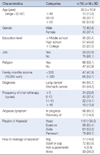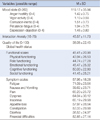Abstract
Purpose
This study was examined to identify the relationship between mood state, interaction anxiety, and quality of life of cancer patients with chemotherapy-induced alopecia.
Methods
The participants were 115 cancer patients. Data were collected from August to December 2012, and analyzed using descriptive statistics, Pearson's correlation coefficients, t-test, ANOVA and Duncan's multiple test.
Results
The mean scores of mood state (119.17±35.94), interaction anxiety (45.57±11.73), and global health status (38.08±22.45), functional scales (45.41±20.98), symptom scales (57.96±18.28) in quality of life were moderate or below. Negative correlations were found between mood state and quality of life, interaction anxiety and quality of life, but positive correlation were found between mood state and interaction anxiety.
Conclusion
These findings indicate that mood state and interaction anxiety are important factors to improve quality of life of cancer patients with chemotherapy-induced alopecia, And it is meaningful in that this study prepared basic data for development of nursing intervention programs for effective management of chemotherapy-induced alopecia.
Figures and Tables
Table 3
Differences of Mood state, Interaction Anxiety by General Characteristics of Participants (N=115)

References
1. Davis ST, Benson BG, Bramson HK. Prevention of chemotherapy induced alopecia on rats by CDK inhibitors. Science. 2001; 291:134–137.

2. Kim IR. Experiences of chemotherapy-induced alopecia in breast cancer patients [dissertation]. Seoul: Sungkyunkwan Univ.;2009.
3. Youn HJ, Jung SH. Care for alopecia during chemotherapy of cancer patients. Korean J Clin Oncol. 2011; 7:34–39.

4. Heo JS. Mood state in cancer patients receiving radiation therapy. [dissertation]. Seoul: Hanyang Univ.;2011.
5. Morris WN. Mood-the frame of mind. New York: Spring-Verlag;1989.
6. Dodd MJ, Miaskowski C, Cho M, Greenspan D. A comparison of the affective state and quality of life of chemotherapy patients who do and do not develop chemotherapy-induced oral mucositis. J Pain Symptom Manage. 2001; 21(6):498–505.

7. Hoffman CJ, Ersser SJ, Hopkinson JB, Nicholls PG, Harrington JE, Thomas PW. Effectiveness of mindfulness-based stress reduction in mood, breast- and endocrine-related quality of life, and well-being in stage 0 to III breast cancer: a randomized, controlled trial. J Clin Oncol. 2012; 30(12):1335–1342.

8. Hesketh PJ, Batchelor D, Golant M, Lyman GH, Rhodes N, Yardley D. Chemotherapy-induced alopecia: psychosocial impact and therapeutic approaches. Support Care Cancer. 2004; 12:543–549.

9. Kim MR. Mediating and moderating effect of identity achievement in the relation between public self-consciousness and social anxiety. Korean J Couns. 2011; 12:721–738.

10. Snyder CR, Smith T, Augelli RW, Ingram RE. On the self-serving function of social anxiety. J Pers Soc Psychol. 1985; 48:970–980.
11. An HJ, Chung BY. Self-esteem and social anxiety of nursing student. J Korean Acad Soc Nurs Educ. 2006; 12:224–228.
12. Lee SH, Chung SE. A study on self-esteem and interpersonal relationship of nursing students. Korean J Womens Health. 2004; 5:133–151.
13. Rosman S. Cancer and stigma : experience of patient with chemotherapy-induced alopecia. Patient Educ Couns. 2004; 52:333–339.

14. Ferrans CE, Power MJ. Quality of life index : development and psychometric properties. ANS Adv Nurs Sci. 1985; 8:15–24.
15. Shim JH, Park KS. A study on quality of life of those who have breast cancer patients taking chemotherapy. J Korean Acad Adult Nurs. 2004; 16:49–59.
16. Jeong JY, So HS, Hong JE, Chae MJ, Han GH. Related factors to quality of life among hospitalized cancer patients undergoing chemotherapy. Asian Oncol Nurs. 2012; 12:84–91.

17. Can G, Demir M, Erol O, Aydiner A. A comparison of men and women's experiences of chemotherapy-induced alopecia. Eur J Oncol Nurs. 2013; 17:255–260.

18. Lee JL, Kim KS. The relationships between stigma, distress and quality of life in patients with lung cancer. J Korean Oncol Nurs. 2011; 11:237–246.

19. Luoma ML, Halamies-Blomqvist L. The meaning of quality of life in patient being treated for advanced breast cancer: a qualitative study. Psychooncology. 2004; 13:729–739.

20. Jang MH, Bae SK. Recognition change before and after wearing wigs of the female cancer patients. J Korea Contents Assoc. 2010; 10:198–205.

21. McNair DM, Lorr M, Droppelman LF. EdITS manual for the profile of mood states. San Diego: Educational and Industrial Testing Service;1992.
22. Kim NJ. Reliabilities and validities of the POMS (Profile of mood states, Korean edition) for the normal high school and college students [dissertation]. Cheongju: Chungbuk National Univ.;2001.
24. Kim NJ. A study on the measurement of social anxiety. Korean J Clin Psychol. 1995; 17:73–81.
25. Kim YJ, Yoo HJ, Kim JC, Han OS. Preoperative quality of life in rectal cancer patients: male vs female. Korean J Clin Psychol. 2003; 22(4):743–762.
26. Oh SH, Bae BG, Park CO, Noh JH, Park IH, Wu WH, et al. Association of stress with symptoms of atopic dermatitis. Acta Derm Venereol. 2010; 90:582–588.

27. Münstedt K, Manthery N, Sachsse S, Vahrson H. Changes in self-concept and body image during alopecia-induced cancer chemotherapy. Support Care Cancer. 1997; 5:139–143.

28. Protière C, Evans K, Camerlo J, d'Ingrado MP, Macquart-Moulin G, Viens P, et al. Efficacy and tolerance of a scalp cooling system for prevention of hair loss and the experience of breast cancer patients treated by adjuvant chemotherapy. Support Care Cancer. 2002; 10:529–537.





 PDF
PDF ePub
ePub Citation
Citation Print
Print






 XML Download
XML Download